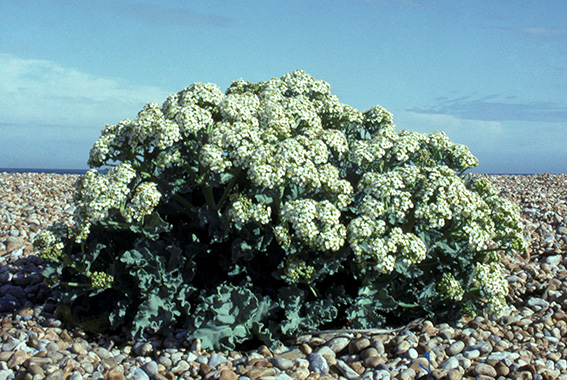As an ecologist, I love exploring salt marshes and shingle banks where conditions are truly extreme for plant and animal alike. Its here that you find sea kale, thrift, yellow horned-poppy, sea lavender, sea pea, sea campion, sea blight and other plants that can cope with the high levels of salt. They are classed as halophytes.
Living in a salt water environment, they are adapted to a physiological drought – just as in the Ancient Mariner “Water, water every where, Nor any a drop to drink”. They have all sorts of adaptations to enable them to survive this hostile environment, especially their leaves that can be thick, succulent, small or waxy to reduce the loss of water through transpiration and store as much as possible. Some have salt glands so they can get rid of excess salt.
To me they are the ultimate climate resilient plant. Looking around my garden at the end of summer, I could see that my drought-tolerant plants have done well but the winners have to be my halophytes. My sea kale and sea beets did not get watered once and they have thrived.
We already grow a number of halophytes in our gardens and they have thrived in the tough conditions of this summer – amongst the best known as the sea hollies or Eryngiums and cardoons (Cynara cardunculus) but they may not be the best choice as they don’t like waterlogging but there are plenty of others. A clue is in the name ‘sea’ in the common name and maritima in the Latin.
Edible halophytes
There is a wide range of edible halophytes that we can grow in the garden or on the allotment. In Mediterranean areas, edible halophytes are very popular and appear in markets and on menus, while we see the occasional samphire on the fish counter.
Halophytes are known for their bioactive compounds, being high especially in phenolics and flavonoids, which makes them healthy options and we need to grow more of them.
Here are a few edible halophytes that you could grow in the garden
Sea kale (Crambe maritima) has to be my favourite, being both ornamental and edible. It’s a relative of the cabbage and has fleshy grey-green leaves and a mass of white flowers in late spring. It’s the young shoots that are harvested – they are a bit like asparagus and can be blanched like rhubarb.
Sea beet or sea spinach (Beta maritima) is a truly resilient plant and quite a thug so beware if you decide to grow this edible. The leaves look like a glossy spinach and are picked in the same way. Its rich in vitamin C and was reported as being picked by sailors to prevent scurvy. It has a scrambling growth habit so will cover a large area quite quickly. I don’t allow it to flower as seedling appear everywhere and they can cross pollinate with chard and spinach. And I suspect its quite allelopathic as I can’t grow much near it.
Summer purslane (Portulaca oleracea) has a fleshy, edible leaf that I grow for salad. Said to be the best source for omega-3. Being half hardy, I grow from seed each year and it copes well with heat and drought.
Saltbush (Atriplex halimus) – a shrub with silver grey leaves that is extremely drought tolerant
Sea blite (Suaeda maritima) low growing perennial with small narrow leaves
Oysterplant (Mertensia maritima) which is found on gravel shores. It’s a low growing perennial with grey-blue fleshy leaves and bell-shaped blue flowers. Its leaves used as a herb as they have a slight hint of fish oil
But there are so many others to try capers (Capparis spinosa), buck’s horn plantain (Plantago coronopus), golden samphire (Inula crithmoides) to name a few
Waterlogging
Over the last few weeks, numerous articles have appeared on growing drought tolerant plants in our gardens to cope with climate change. But my worry about this approach is that our changing climate is so variable – we do not yet have a warmer climate. Yes, we are moving towards a warmer climate, especially in southern England but we are in a transition period and this makes it really tricky. I have long described this type of weather as topsy turvy with the weather flipping from one extreme to another. We have experienced the coldest May, the wettest August, the warmest February in recent years. Our summers may warm up, but more rain will fall in extreme weather events and its increasingly likely that our winters may be mild and wet – the type of climate that many drought-tolerant perennials including halophytes will not enjoy. They need good drainage and with my heavy clay soil, I am looking to growing them on thick gravel beds instead.
A future for halophytes
We may see more salt tolerant plants in the future, as interest in this group of plants is growing. Around the world, coastal areas are seeing rising sea levels with more coastal areas suffering from sea water inundation, so we may have to rely more on growing plants in saline areas. There is lots of research going on in India for example, to breed plants that can cope with salt water.
